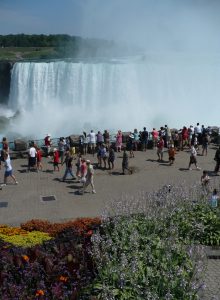
The worst thing one can do at Niagara Falls is to simply stop and look at the falls.
Niagara Falls might be an iconic North American destination, but there is so much to do here than stand and watch. The best way to experience Niagara Falls is to explore the scenery, to become part of it, to meet nature head on. If you don’t get wet here, you haven’t gotten your time or money’s worth out of your trip.
For those who don’t know their way around this world wonder, here is a Niagara Falls primer.
Where exactly is Niagara Falls?
There is a two-part answer to this question since there are the cities of Niagara Falls and the Niagara Falls water spectacles.
First, the cities. Niagara Falls, New York sits across the Niagara River from Niagara Falls, Ontario. They are separate cities with identical names in neighboring nations and are located about twenty miles north of Buffalo, New York. [Side note: The Niagara River is technically not a river, but a roughly thirty-five-mile-long strait connecting Lake Ontario to the north with Lake Erie to the south.]
Now, the water. Two islands separate Niagara Falls into three sections: American Falls, Bridal Veil Falls, and Horseshoe Falls. Bridal Veil Falls is a narrow slip of a waterfall, separated from sprawling American Falls by the tiny Luna Island. Both are located in the state of New York.
Bean-shaped Goat Island separates Bridal Veil Falls from the majestic and appropriately named Horseshoe Falls, all but a very small portion of which is in Ontario.
There are a lot of waterfalls across the globe. Why are Niagara Falls so famous?
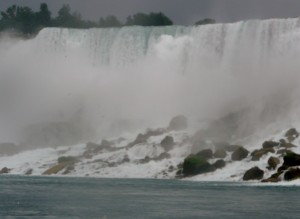
In a word: power.
Plenty of waterfalls are higher, but the sheer breadth and water volume of Niagara Falls is staggering. Curious travelers started coming to see this natural marvel as early as the mid-1700s. The arrival of the New York Central Railroad in the mid-1800s made access much easier. The railroad promoted Niagara Falls as an ideal honeymoon destination and has been associated with romantic getaways ever since.
What are the dimensions?
For statistic buffs: American Falls and Bridal Veil Falls drop about 180 feet. Horseshoe Falls drops 170 feet. American Falls are about 1,100 feet wide. Bridal Veil Falls are about 55 feet wide. Horseshoe Falls are roughly 2,700 feet wide. By comparison, Taughannock Falls, just 150 miles to the southeast, has a vertical drop of 215 feet and Yosemite National Park’s Bridalveil Falls in California has a vertical drop of roughly 620 feet, but both are shoelaces compared to Niagara in width and absolute energy. The vital stats all depend on the season, the weather conditions, and how much water is being diverted for power generation.
Where is the best place to begin a visit?
This answer is a specific one: In a seat in the theater at Niagara Falls State Park Visitor Center on the New York side, watching Niagara: Legends of Adventure. The forty-minute-long movie, shown on a fifty-foot screen, uses historic recreations and glowing cinematography to introduce you to the natural and human history of the falls, from the wonders of geology to Native American legends to 20th century daredevils.
What are the best ways to experience Niagara Falls?
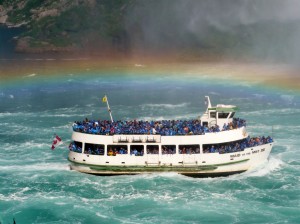
There are three prominent attractions that will allow you to get up close and personal, and you’ll want to don rain slickers at all three.
- Maid of the Mist boat tours: The boat leaves from the American side and sails to the brink of Horseshoe Falls. Expect to be bumped, jostled, and sprayed on the thirty-minute-long trip. The power of water is overwhelming as you approach the cannonading cascades. From overhead, the human cargo in blue rain slickers resembles a floating garden of blue bells. Maid of the Mist is generally in operation mid-April through October 24.
- Cave of the Winds: Picture the correspondents on The Weather Channel who report in the midst of hurricanes. The closest thing for the rest of us might be Cave of the Winds on Goat Island, located on the American side. And yes, there once was a cave in this chunk of the earth, until a 1954 natural rock fall and subsequent dynamiting for safety purposes occurred. Visitors here sport yellow rain slickers and throwaway flip-on shoes before taking an elevator 175 feet down to the base of Bridal Veil Falls. From there you’ll walk along wooden staircases and decks among the spraying torrents. Hair gets drenched and mist clouds eyes. The thundering sound of the falls at the aptly named Hurricane Deck, the closest spot one can get on the American side to Niagara Falls, is like standing in an airplane hangar. Cave of the Winds is usually fully operating from May through late October. It is open in limited capacity late March through April and late October through December
- Journey Behind the Falls: You start this journey by putting on yellow rain slickers and descending about 13 stories in an elevator at the retail and dining complex known as Table Rock Center on the Ontario side. Tunnels lead you to three observation points – two are literally behind the falls and viewed behind a barrier while the other takes you to both enclosed and open observation points beside Horseshoe Falls. Journey Behind the Falls is open year-round.
What are the spots for bird’s eye viewing?
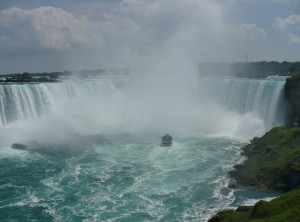
Only from the Canadian side can one get a complete panorama of all three segments of Niagara Falls. We found the overview from Table Rock sufficiently inspiring. But if you want to see the falls from an even greater altitude, head to the 525-foot-high Skylon Tower or the 175-foot-high Ferris wheel known as the Niagara Skywheel, both on the Canadian side. On the American side, the Prospect Point Observation Tower rises 260 feet above the American Falls; at its base is the departure point for the Maid of the Mist boat tour. The best viewing spot on the American ground is from Terrapin Point on Goat Island.
You won’t be here long before noticing the natural rainbow over the river. And throughout the year, the evening falls are illuminated nightly May through February, later limited to only Friday through Sunday in March and April. In season, there are fireworks shows on weekends and major Canadian and American holidays.
What if it rains?
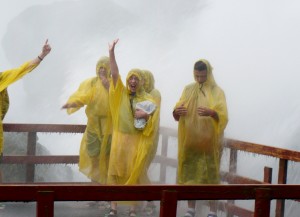
You get wet. But if you ride the Maid of the Mist, explore the Cave of the Winds, or experience Journey Behind the Falls, it won’t make any difference. On our visit, we experienced a showery day under a steel gray sky, then a sunny and clear one. The Niagara River responded to the conditions appropriately, looking dusky and rough on the first day, bright and deep blue the next. Both days lent themselves to contrasting memories and amazing photographs.
What is it like crossing into Canada?
While Niagara Falls might seem to be one big happy play land for vacationers, the region is separated by an international border and the customs and border patrol agents mean business. Prepare to be questioned on what you are bringing into the country you are entering and expect to be asked to show a passport or other government issued proof of citizenship. All USA citizens require proper documentation such as a passport, passport card or a driver’s enhanced license. Children 16 years of age and require only a birth certificate.
What is the season?
Memorial Day through Labor Day, with July and August being the busiest months. Shoulder seasons are April until Memorial Day and Labor Day through October; fall foliage season is becoming increasingly popular here. Niagara Falls is striving to become a year round destination, and some attractions are opting to stay open through the winter months. That being said, the period staring from December through March marks the slow season.
How crowded does it get?
The roar of the water is not the only sound you’ll hear, and no one will ever be lonely in summer. The sounds also include seas of visitors conversing in a Babel of languages. Yellow and blue rain slickers are scattered on the ground like dropped ice cream cones. It is significantly quieter the rest of the year.
Is Niagara Falls a national park location?
No, neither in the United States nor Canada. Niagara Falls was exploited long before the first national parks were established. However, the American Falls are located in Niagara Falls State Park, the oldest state park in the country.
Are there any lesser known sites around the falls worth seeking out?
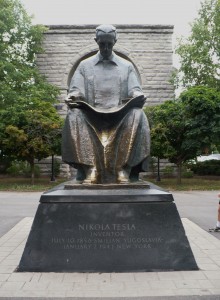
My daughter, an electronics guru, was thrilled to stumble across the immense Tesla Memorial, a statue of the celebrated electromagnetism pioneer. It is located by the Cave of the Winds entrance on Goat Island. In the Upper Niagara River between Goat Island and the Ontario shoreline is the hull of a wrecked scow, stranded here since 1918 when a tugboat pulling it ran into rocks. The fact that it has remained stuck amid the river’s perilous currents for ninety years has made it a peculiar visitor attraction in its own right.
What else is there to do here?
Lots. The Canadian side has a rash of “facky” (fun, tacky, or both, depending on your point of view) attractions, most of which are located along the thoroughfare known as Clifton Hill. Few have anything to do with the falls, and include a Guinness World Records Museum, a Ripley’s Believe It or Not Museum, a couple of wax museums, a motorcycle museum and, well, you get the idea. The most sublime Canadian side attraction is likely the aquatic theme park, Marineland. A few miles away from the glitz of Clifton Hill at the Sir Adam Beck Generating Station in neighboring Queenston is one of the world’s largest working floral clocks, and it is a work of art in its own right.
The biggest supplementary attractions on the American side are an aquarium and a new Snow Park Niagara Falls for those who can’t wait for the next Buffalo-area winter to come. Park highlights include a ten-lane tubing hill, a skating park, and a play area where one can make a snowman or build an igloo in August. In addition, there are two casinos on the Canadian side and one in New York.
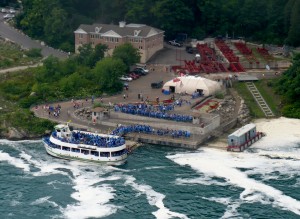
How can I get further information?
On the New York side, contact the Niagara Tourism & Convention Corporation at (877) FALLS-US (325-5787) or (716) 282-8992.
On the Canadian side, contact Niagara Falls Tourism in Ontario at (800) 56-FALLS (563-2557) or (905) 356-6061.

